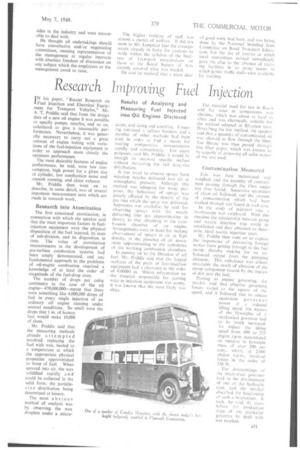Research Improving Fuel Injection IN his paper, "Recent Research on
Page 33

If you've noticed an error in this article please click here to report it so we can fix it.
'Fuel Injection and Electrical Equipment for Transport Vehicles," Mr. A. T. Priddle said that from the design data of a new oil engine it was possible to specify pumps, nozzles, and so on, calculated to give a reasonable performance. Nevertheless, it was generally necessary to carry out a great amount of engine testing with variations of the fuel-injection equipment in order to approach more closely the optimum performance.
The most desirable features of engine performance, he said, were low consumption, high power for a given size of cylinder, low combustion noise and smooth running, and clean exhaust.
Mr. Priddle then went on to describe, in some detail, two of several important measurement tests which are made in research work.
Research into Atomization
The first concerned atomization, in connection with which the speaker said that the most important factors in fuelinjection equipment were the physical disposition of the fuel injected, its state of sub-division, and its disposition in time. The value of atomization measurements in the development of gas-turbine combustion systems had been amply demonstrated, and any fundamental approach to the problems of oil-engine combustion required a knowledge of at least the order of magnitude of the fuel-drop sizes.
The number of drops per cubic centimetre in the case of the oil engine-470,000,000—meant that there were something like 4,000,000 drops of fuel in every single injection of an ordinary oil engine running under normal conditions, So small were the drops that 1 in. of human hair would make 10,000 of them.
Mr. Priddle said that the measuring methods already attempted involved replacing the fuel with wax, heated to a temperature at which the appropriate physical properties approximaied to those of fuel. When sprayed into air, the wax solidified rapidly a n d could be collected in the solid form, the particlesize distribution being determined at leisure.
The most obvious method of analysis was by observing the wax droplets under a micro
scope, and siring and counting. Count
ing remained tedious business and a number of other methods had been tried in order to find a means for making comparative measurements rapidly and conveniently. For many purposes. said Mr. Priddle. it would be enough to measure specific surface without measuring the full drop-size distribution.
It was usual to observe sprays from injection nozzles delivered into air at atmospheric pressure. Although this method was adequate for many purposes, the behaviour of sprays was greatly affected by the density of the gas into which the spray was delivered. Apparatus was available, he said. for .observing sprays with the nozzle delivering into gas approximating in density to that obtaining in the combustion chamber of an engine. Arrangements werein hand for making observations of sprays in air it high density, in the presence of air movement approximating to the turbulence of the working combustion chambers.
In passing on to the filtration of oil fuel. Mr. Priddle said that the lapped surfaces of the parts of fuel-injection equipment had a clearance in the order of 0.00004 in. Whilst information on the material responsible for causing wear in injection equipment was scanty, it was known that the most likely was
The material used for test in filters and for wear in components W;t1+ alumina, which was about as hard as silica and was chemically suitable for the method adopted in filtration tests. Describing the test method. the speaker said that a quantity of contaminated oil was allowed to flow through the filter. The filtrate was then passed through, fine filter paper, which was known to he capable of removing all solid matter of the size used.
Contamination Measured • rhis was then incinerated and weiabcd, and the quantity of contaminem passing through the filter under test thus found. Successive quantities i>f clean oil followed, and the amount of contamination which had been washed through was found in each ease.
In the study of injection rate, a stroboscope was employed. With this machine the relationship between pump and nozzle injection rate could be established and data obtained to determine ideal nozzle injection rates.
Mr. Priddle then went on to explain the importance of preventing foreign matter from getting through to the fuel pump, thereby making for an unbalanced output from the pumping elements. This unbalance was almost invariably the result of abrasion of the pump component caused by the ingress of dirt into the fuel.
Passing to engine governing, the speaker said that effective governing forces varied as the square of the speed, and it followed that to obtain
equivalent gov erno r power at a reduced idling speed, the masses of the fly;weights of a mechanical governor had to be much increased. To reduce the idling speed from 400 to 225 engine r.p.m. necessitated an increase in flyweight mass of over 200 per cent., which, at 2.000 engine r.p.m., involved forces in the order of 330 lb.
The shortcomings of he mecir n:cit governor lead to the development of one of the hydraulic type, and the speaker Llescr:bed the functioning of such a mechanism. It took. he said. 4-1 year:: before the production stage of the particular governor he dealt with was reached.












































































